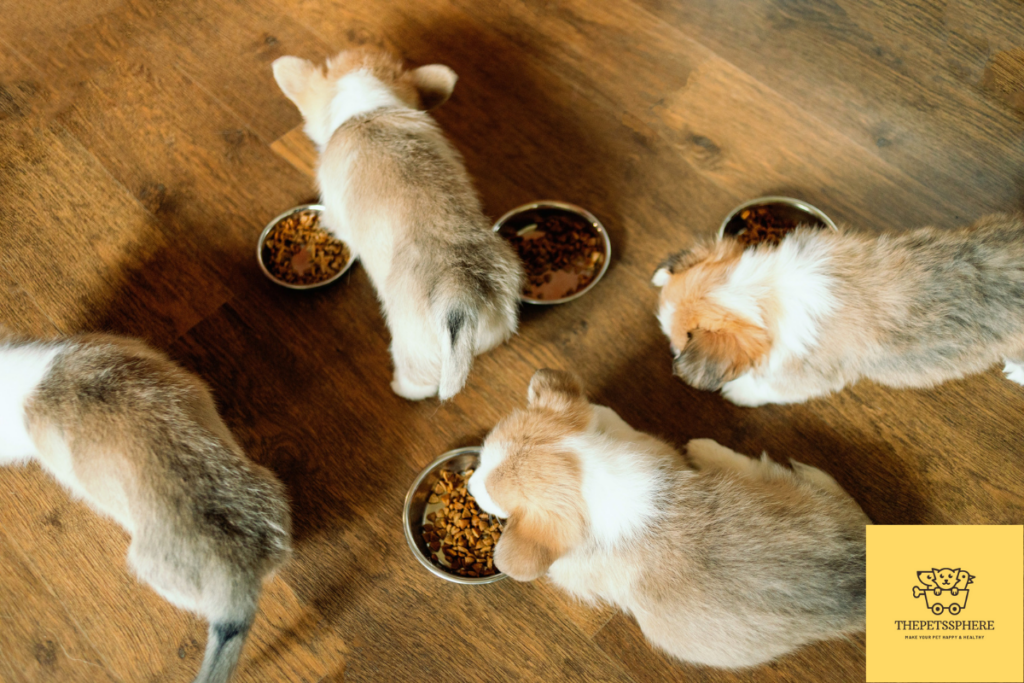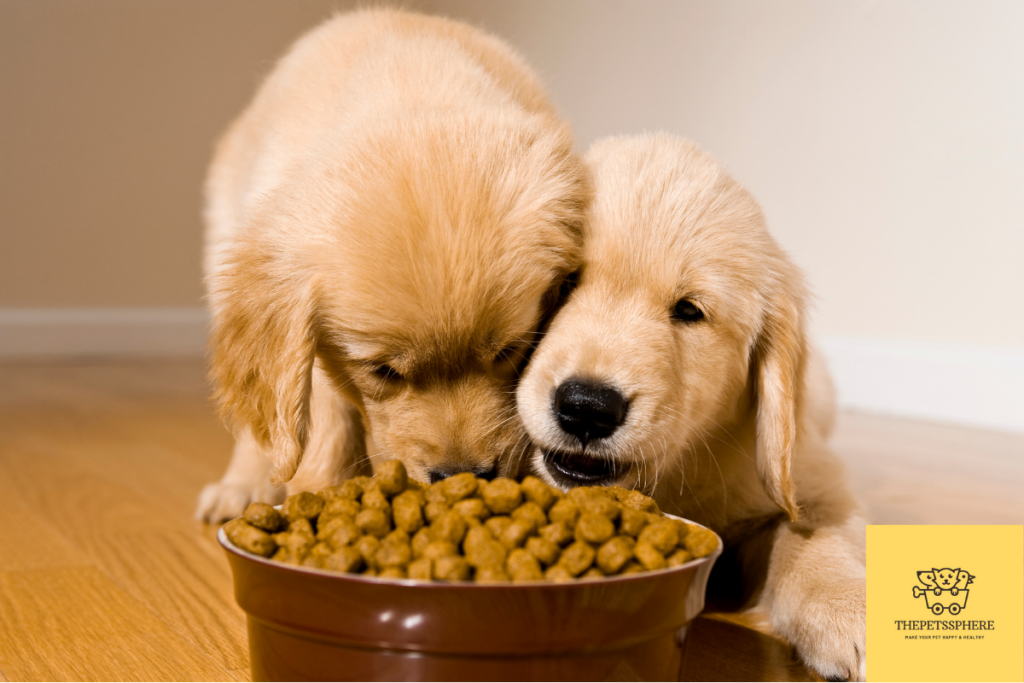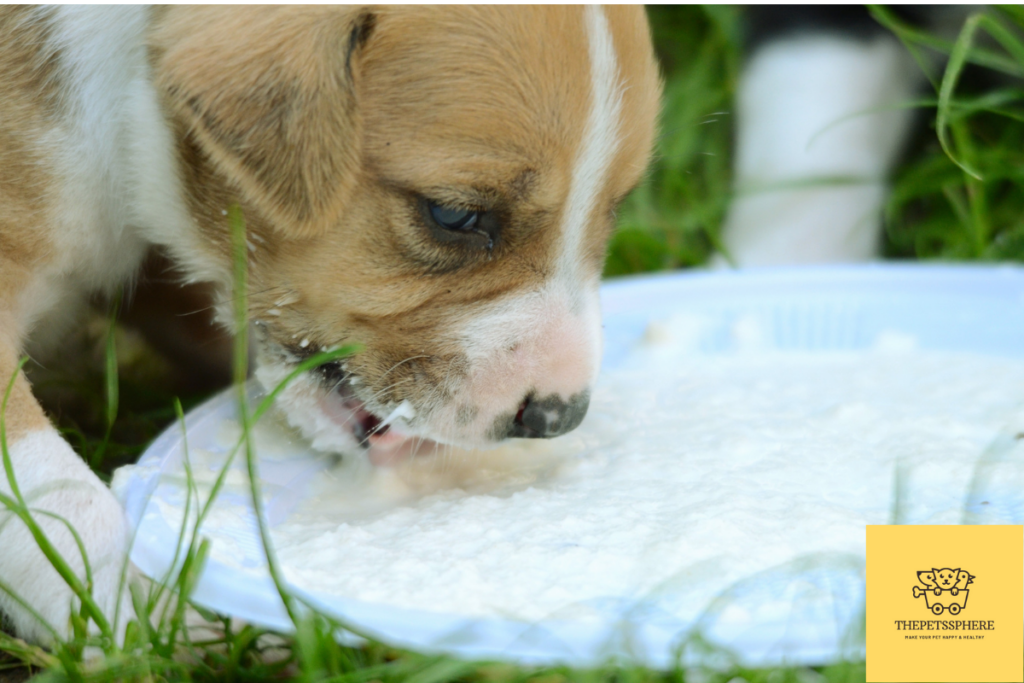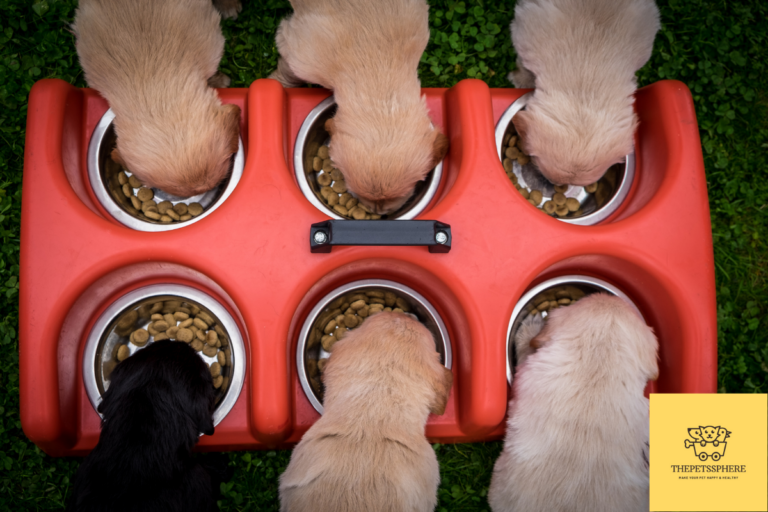Choosing what to feed your new puppy can be an overwhelming task. There are so many options and different opinions on which foods are best for dogs, that it’s hard to know where to start! But don’t worry, we’re here to discuss the fundamentals of feeding puppies. We’ll talk about what you should feed puppies in order to make them healthier and live a long life.
Lastly, I’ll answer some frequently asked questions so you can get all your puppy feeding fundamentals covered!

What should I feed my Puppies?
The thing is, Puppies should only be given High Quality Puppy Food.All brands of Puppy Food are good so you should not worry about choosing the right one.
Puppies need more fat in their diet than adult dogs because they’re growing and developing quickly, which is why a high-quality puppy food will include a higher percentage of protein from animal sources to provide essential nutrients like omega-fatty acids and DHA, as well as higher levels of fat for energy
Next,it’s important to feed your puppy three times a day.The amount per meal will depend on the size and breed of dog but it should be somewhere between ¼-½ cup (30g) each time.
Lastly, puppies need more calories than adult dogs because they’re growing and developing quickly.
How do Puppies Nutritional Requirements Differ from Adult Dogs?
The nutritional needs of puppies are different from the needs of adult dogs. Puppies need more calories, protein and fat for growth, as well as specific nutrients that support their immune system and digestion. They also have a higher risk of developing certain diseases like bloat or hypoglycemia when they are fed diets too high in carbohydrates. In this blog post we will discuss three ways how do puppies nutritional requirements differ from adult dogs:
1) Calories – A puppy has double the number of calories per pound than an adult dog.
2) Protein – The protein requirement is based on percentage rather than weight.
3) Fat – Too much fat can lead to obesity and heart disease while not enough fat can result in skin conditions or stunted growth.
How much to Feed a Puppy?
As a pet owner,you must be aware about what type of food you’re feeding your puppy. The general rule for puppies is that they should be fed three to four times a day, or in some cases up to six times per day. If it doesn’t say on the can then check with the producer before feeding more often than once a day.
Puppies are usually hungrier when waking from their nap as well so make sure not to miss feedings at these intervals; if he seems hungry after just two hours, go ahead and give him another small meal – but don’t overfeed!
Feeding schedule
You may need to vary the amount based on how quickly they eat or drink–if he’s gulping his food down without chewing, he’s probably not feeling too hungry and you can wait a while before feeding him again.
Don’t forget about water
Puppies also need fresh, clean water available to them at all times for the health of their kidneys (which are still developing) as well as other systems in their bodies that rely on this vital substance.
Don’t Overfeed them
If you think that your puppy is overeating,then there are some ways to stop that.The best way to stop puppies from overeating is by feeding them three meals a day instead of free-feeding or leaving food out at all times. This will allow you to monitor the amount of food they’re eating throughout the day.
Some people might also leave a high-quality ball treat in their dish so that only when they’ve finished all their food, can they have the special snack which will give them more incentive to stop after finishing everything on their plate!
Can I feed my Puppy Raw Food?
Yes, your dog can eat raw food. It’s best to consult with a vet before any changes in their diet though!
If you’re going this route then make sure that you know exactly what type of meat should be included (i.e., red meats are too high in protein and not very digestible for dogs).
Raw food diets are best for dogs with allergies and digestive problems. If your pup has been diagnosed with any of these then it’s worth a try!
One important thing is that ,don’t try to make Homemade Raw food for your Puppy. You will need to consult with a vet before experimenting in the kitchen.So, if you are thinking about making your own raw food for your puppy, there are some reasons why you should not do so.
1) Poor Nutritional Balance
Homemade raw diets may lack essential nutrients or have too much of others like protein which can lead to health problems down the road such as kidney failure and heart disease.
2) Too much work
It takes a lot of time and effort to make sure that the diet is balanced nutritionally in order to meet all requirements for puppies at various stages of growth.
3) Risky
There is a risk that your homemade diet may be contaminated with bacteria or parasites.So before offering any homemade diet to your puppy,please consult with your vet first.
When to start Feeding Puppies Wet Food?
Puppies usually need to be fed a wet food diet when they are around 12 weeks old.
It is important that the puppy eats from his bowl, not another surface or individual mouth because it makes them more likely to develop oral health problems in adulthood.
Start with high quality kibble (with a lower protein) – this will help the puppy grow well and develop into an adult with less chance of obesity or other problems.
At 12 weeks, make sure to feed them quality wet food (with higher protein). This should be done because it provides more nutrition for growth than kibble does!
A few things you don’t want to give puppies include chocolate, onions and garlic, coffee or tea, avocado and grapes because they can be harmful to your pet.

How do I know if my puppies Kibble Meet their Nutritional Needs?
We refer to the Association of America as AAFCO. They are responsible for establishing guidelines that pet food meets when it is labeled and marketed as “complete and balanced.” All pet foods sold in the U.S. must meet these specifications or they cannot be marketed to pets here. In order to qualify, a complete and balanced diet must provide the animal with a level of nutrition that will maintain an animal at an appropriate weight; prevent nutritional deficiencies; prevent diseases; promote reproductive health, growth, development, and produce normal levels of energy.
Look at the food label. A product labeled “Puppy Formula,” “All Stages of Life” or “ALS” is formulated to meet all the nutritional needs for a growing puppy and will provide all the required nutrients. Measuring your pup’s intake once per day with a food bowl allows you to adjust accordingly by adding water, more food, or less food depending on their weight and activity level to make sure they maintain optimal nutrition.
The best thing you can do for your new puppy is provide them with fresh, nutritious foods that have increased protein requirements (to help with muscle development) and decreased levels of calories as well as fat (which must be limited during these precious pup years). This helps their diet stay lean and will help them achieve a healthier weight.
The top 3 things that can tell you if kibble is meeting the nutritional needs of your puppies? This blog post will give you these insights.
1) If your dog’s coat looks dull and dry, this could be a sign that they are not getting enough protein in their diet.
2) Dogs need calcium for strong bones and teeth; look for food with added calcium or consider adding some cheese, yogurt or eggs to your dog’s diet once in a while.
3) Puppies usually eat about 3 cups per day; check the label on the back of the bag to find out how many calories it has per cup so you can make sure they stay at a healthy weight.
Why do Puppies Cry when Feeding?
It is a common question for dog owners: why do puppies cry when being fed?Now let’s explore 3 potential reasons that may be the cause of these cries.
1) The pup’s stomach might not be empty. If the pup was just eating, then he or she might still have food in their stomach and it could feel uncomfortable to eat more food without letting time pass first.
2) The pup may not like the taste of what’s being given to him or her – there are different types of tastes and textures that can make some pups squeak with delight while others would rather never see it again.
3) Sometimes a dog will refuse to eat because they have an upset tummy from something they ate earlier in the day. If your pup is refusing to eat, they might have an upset stomach from something else that was eaten earlier in the day and it could be best to give them a break until tomorrow morning before trying again.

What Kind of Milk Can You Feed Puppies?
Puppies need to drink milk because they are growing and it’s important for their growth. But, what kind of milk can puppies drink? First off, you want to make sure the milk is fresh. If there are any questions about that, then it’s best not to feed your pup dairy products just yet. You’ll also want to avoid whole cow’s milk as well as soy or almond-based milks unless your vet has prescribed them for a specific reason. Stick with something like 2% or skim if possible!
You can bottle feed Puppy Milk Formula ,choose a Puppy Milk replacer especially made for puppies.
You should avoid them offering Cow’s milk or Goat’s Milk as they won’t be able to digest it properly.
Final Thoughts
The journey from puppy to adulthood is fun, exciting, but also critical to your dog’s future development. What you feed them now will impact their health and life in the long-term. AAFCO (or NRC) approved food helps ensure that they are getting all of the nutrients and vitamins they need for optimal growth while still giving them a taste experience like no other! Once your pup turns 4 months old be sure to transition off any puppy formula foods as this can lead to serious bone issues down the road. Now is an excellent time to start thinking about what type of adult food would work best with your new companion’s lifestyle and preferences too! With so many options available it can feel overwhelming trying to figure out which one is best. But, with a little guidance and expert opinion from your veterinarian you should be able to make an informed decision that will have a positive impact on not just their quality of life but yours too!

